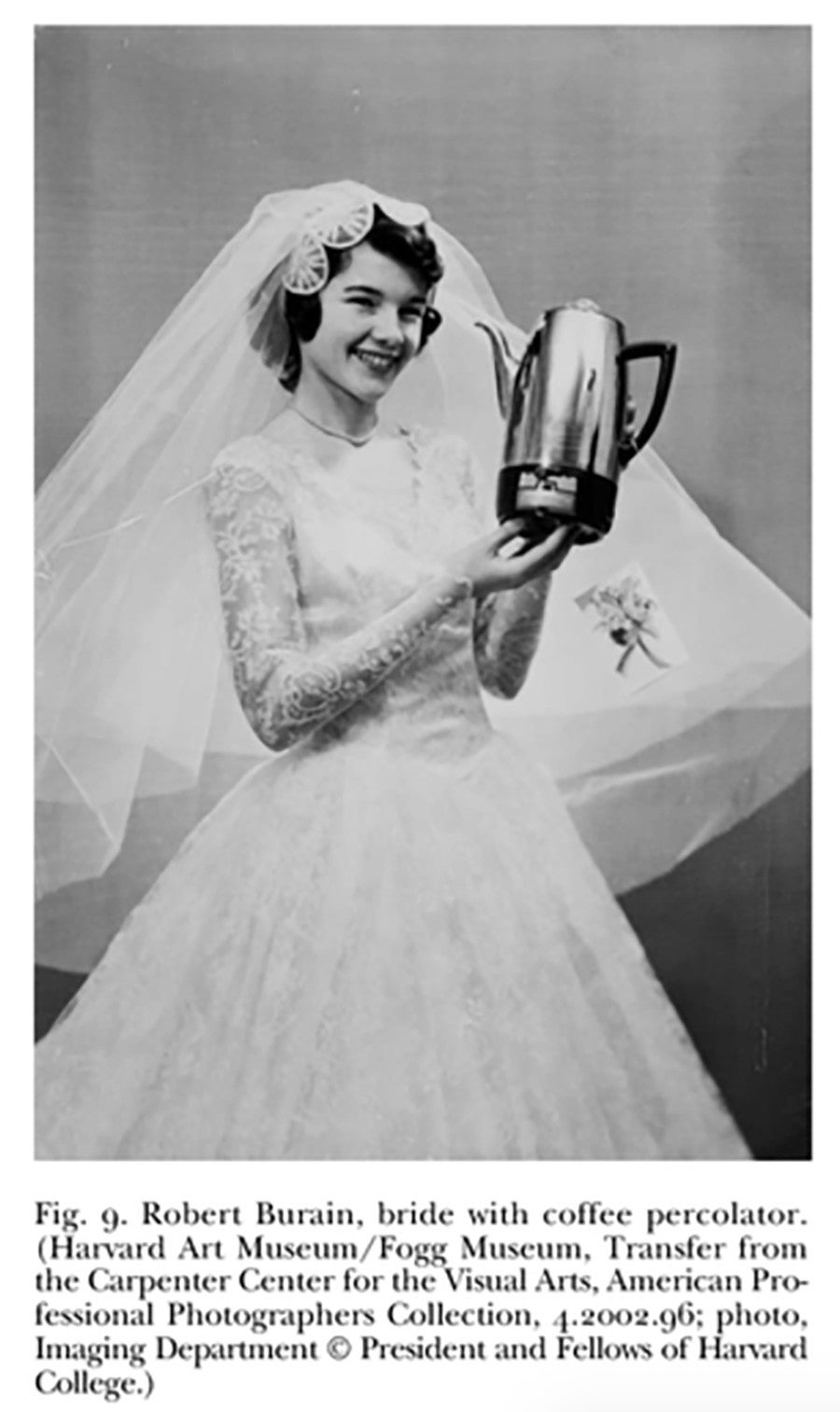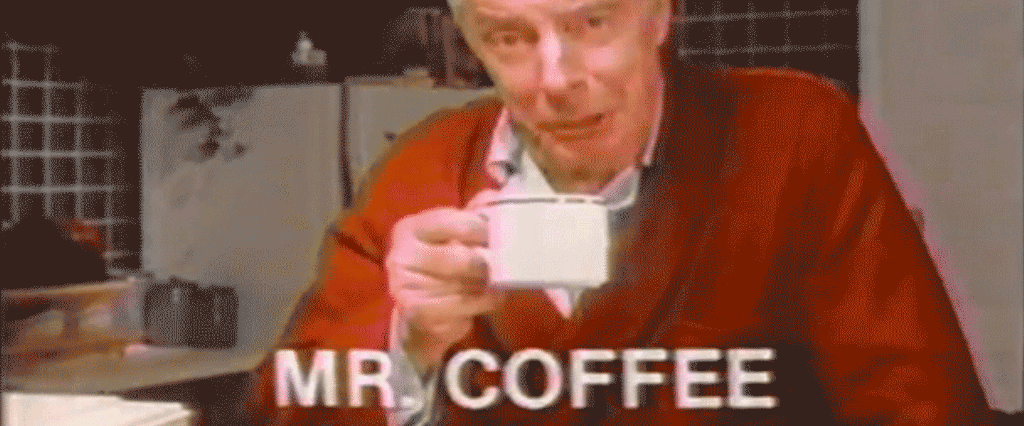There are competing theories about the origin of the term “cup of joe.”
Some say “Joe” is slang for the common man; hence a cup of joe is the common man’s drink. Others claim the term was born in 1914 when Secretary of the Navy Josephus Daniels issued General Order 99 prohibiting alcohol aboard naval vessels. Out of spite, disgruntled sailors allegedly began referring to the strongest drink available to them as a cup of Joe. Linguist Michael Quinion offers still another theory: It’s simply shorthand for two other terms for coffee — java and jamoke.
One thing is certain, though: It’s not a cup of Joanie.
And yet, as historian Rebecca K. Shrum writes, there was a considerable amount of time in American history — measured in decades, if not centuries — when the primary coffee-makers were women. They mostly brewed all those cups of joe with stovetop percolators, multichambered pots in which boiling water rose through a central tube and filtered back down through a basket of ground coffee beans. Along with blenders, the percolator was a standard wedding gift in the 1950s.

This method, however, produced bitter, scorched coffee and gave American women a nasty reputation for making awful coffee. In turn, husbands dickishly blaming their wives for shitty coffee became a go-to advertising trope:
“Had it been a really great coffeemaker,” Shrum tells me, “the percolator probably wouldn’t have been that feminized, because men were considered the experts in all things technical at that point.”
In 1972, however, the way Americans made coffee was changed forever by Mr. Coffee, the first electric-drip coffee machine for home use. As opposed to arbitrarily circulating boiling water — like the percolator did — Mr. Coffee produced a regulated, uniform brewing temperature that resulted in a much better flavor.
With it came a giant dose of manly marketing — all those years of lady coffee be damned. For no other reason than that men were seen as the authority on technology, Vincent Marotta, the creator of Mr. Coffee, wanted his revolutionary machine to be a man. To ensure nothing was lost in translation, Marotta didn’t just have any man rep his brand; instead, he chose the manliest man in the world (or at least the U.S.), Yankees legend Joe DiMaggio, to be his spokesman.
Shrum says this was especially effective because Mr. Coffee came on the scene in the 1970s, just as middle-class white women were going to work for the first time — and they needed help luring their husbands into the kitchen, and keeping them there.
“Mr. Coffee boldly sat on the countertop,” Shrum explains. “As a man approached, he pictured Joe DiMaggio, and it became a less scary thing. Studies show that men also began contributing more to other household labor during this period. I think of Mr. Coffee as sort of a gateway drug into the kitchen.”
Even so, it was such a foreign concept at first that DiMaggio never actually made coffee in the early Mr. Coffee commercials. “In one ad,” Shrum says, “he’s in a really dark library surrounded by lots of books — not exactly a place you’d think of coffee. The kitchen was so feminized they just couldn’t imagine anybody would buy a product from Joe DiMaggio if he was selling it in the kitchen.”
In fact, it took about a decade (roughly until the mid-1980s), before Joltin’ Joe saunters into the kitchen in a bathrobe having clearly made the coffee himself. Or rather, he explains, “Last night, I programmed Mr. Coffee to have my coffee ready when I get up!”
Of course, there were two other historical types of men who were indelible coffee drinkers — soldiers and cowboys. (Like DiMaggio, they were so manly that not even brewing their own coffee could diminish their potent man powers.) “During the Civil War, for example, coffee was an important item in the rations of Union soldiers,” Shrum writes in her 2012 paper, “Selling Mr. Coffee: Design, Gender and the Branding of a Kitchen Appliance.”
“Union veteran F. Y. Hedley described the coffee brewed during the war as ‘strong enough to float an iron wedge.’ Pennsylvanian William Hamilton claimed he could ‘drink two and three quarts a day easily and want more.’ Cowboys could too — the stronger, the better. Ramon Adams, in his reminiscences of cooking on the trail, recalled how cowboys liked their coffee in this exaggerated recipe: ‘Take one pound of coffee, wet it good with water, boil it over a fire for 30 minutes, pitch in a horseshoe, and if it sinks, put in some more coffee.’”
Oddly enough, though, today’s version of the male coffeemaker — the hipster barista with well-appointed facial hair — is the antithesis of the rugged cowboy. Journalist Rachel Grozanick pointed out in 2015 that as the coffee industry became more widely perceived as a “skilled” job, the culture also became more masculine — i.e., entire brands were built around the idea of manly coffee. “In my experience,” she reported, “the manly coffee trend was in tandem with baristas putting more emphasis on the importance and complexity of coffee rather than on giving the customer a great experience.”
It’s not surprising, then, that the world of competitive coffee — which Grozanick describes as “part Olympics, part dog show” — has been largely dominated by men. (And mansplaining.) “If I was an animal, I would be a puma,” explains 2013 World Barista Championship finalist Pete Licata, “because I like to sneak around and pass on things.”
Sabine Parrish, an anthropology doctoral candidate at Oxford who wrote her master’s dissertation on gender in U.S. specialty coffee says there’s a systemic bias favoring men’s participation in barista competitions.
It goes like this: At your local cafe, a customer orders a drink at the register, pays and tips based on an expected future drink quality. Parrish’s research found that customers tip higher when there’s a female employee at the register doing the customer service and a male employer doing the coffee work on the machine.
“Customers feel explicitly more comfortable with a man on the machine,” she explains. “It’s basically a boys-and-cars mentality. Boys play with machines, and boys are better with anything technological. It’s very ingrained, and we’re socialized into thinking who we expect to be technologically competent. And it’s not women.”
The result? At the 2016 World Barista Championship, 52 of the participants were men, while 13 were women.
Parrish says men’s embrace of the tech side of coffee — now at barista championships, then with Mr. Coffee — can be traced back to the single-shot espresso machine invented by Luigi Bezzerra and Desiderio Pavoni, which premiered at the 1906 Milan Fair. “We couldn’t have the espresso machine without male-driven technologies — steam and trains — tied into the Second Industrial Revolution in Italy in 1860–1913,” Parrish explains.
I follow up by asking her how she knows men aren’t just innately better at making coffee.
“If we had to go purely by barista championship rankings, it’s going to reveal that men do make better coffee,” she responds. “But then we have to look at the criteria upon which people are judged — dress codes, public presentation, eye contact, etc. For example, a lot of female participants said there was a very fraught decision to make about how to dress when being graded on presentation: If they dressed too feminine, they weren’t taken seriously. But if they dressed too masculine, judges felt they weren’t being true to themselves as women. It was a catch-22.”
Likewise, Cindy Ludviksen, the managing director of World Coffee Events, the company that produces the World Barista Championship, insists those numbers aren’t representative of the day-to-day reality outside of the hipster coffee shop world. “In the chain of coffee, there are numerous opportunities along the way in lots of different roles that don’t discriminate based on gender,” she tells me.
“…There are numerous associations and NGOs with women in executive roles. A huge number of farms are owned by female producers in a lot of countries. Women often run the coops and mills. There’s a growing number of female roasters, which traditionally has been considered a masculine role because there’s a lot of heavy lifting of big sacks of green coffee. There’s even a hashtag #shestheroaster trending in popularity.”
None of which explains why her competition last year had four times as many men as women.
“Ms. Parrish’s research may have found that women aren’t getting as much support from retailers and store owners because people who are more confident and express an interest in competing are typically male. I heard of a similar study that showed when men read a job description they think I can do all that while women think I can try. So it’s not necessarily indicative that coffee isn’t welcoming to women; the competition scene just requires people who are very confident. Historically we’ve seen that it’s been men who have shown that level of confidence and jump right in.”
As for Mr. Coffee, it continues to dominate the drip market with five of the 20 best-selling coffeemakers on Amazon.
Its latest innovation, a method dubbed “Optimal Brew,” flash-heats the water and delivers it to the beans within a temperature range of 195–200 degrees, allowing 10 cups to be brewed in less than eight minutes. The update was engineered by TEAMS Design USA and won a Red Star Award and Excellence in Design Award from Appliance Magazine.
The gender breakdown of the 80 team members who make up TEAMS Design USA?
Nineteen women and 61 men.

